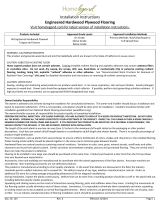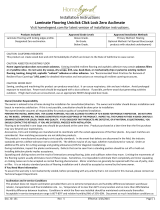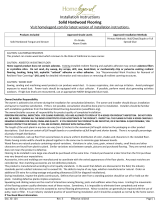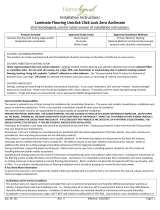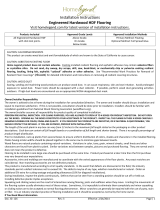Page is loading ...

Installation Instructions
Waterproof Core Vinyl Planks
Visit homelegend.com for latest version of installation instructions.
Doc. ID: 186 Rev: 2 Effective: 1/7/2015 Page | 1
Products Included
Approved Grade Levels
Approved Installation Methods
Waterproof Core Vinyl Planks
Click Lock Joint
Above Grade.
On Grade.
Below Grade.
Primary Method: Floating.
Owner/Installer Responsibility
The owner is advised to be at home during the installation for consultation/direction. The owner and installer should discuss installation and
layout to maximize satisfaction. If this is not possible, consultation should be done prior to installation.
The owner/installer assumes all responsibility for product quality of completed installation.
PERFORM PRE-INSTALL INSPECTION. FOR CLAIMS PURPOSES, YOU ARE ALLOWED TO OPEN UP TO 4 BOXES FOR PRODUCT INSPECTION. DO NOT OPEN
ALL THE BOXES. OPENING ALL THE BOXES CONSTITUTES YOUR ACCEPTANCE OF THE PRODUCT. INSPECT ALL THE PLANKS IN THESE 4 BOXES CAREFULLY.
EXAMINE FLOORING FOR COLOR, FINISH AND QUALITY. IF YOU DISCOVER THAT PRODUCTS ARE DEFECTIVE, OR IF MATERIAL IS QUESTIONABLE, YOU
SHOULD CONTACT THE RETAILER. IF YOU ARE SATISFIED, PROCEED WITH INSTALLATION.
Flooring to be installed in one large area should be purchased at the same time. Product purchased at a later time than the first purchase
may vary beyond your expectations.
This product is manufactured according to strict quality standards. In the event that defects are discovered in the field, the industry
standards permit a defect tolerance not to exceed 5%. Order an additional 5% (10% extra for diagonal installations) for cutting wastage and
plank replacement when the floor is in service.
During installation, inspect the planks continuously. Defects that can be seen from a standing position should be cut off or held out.
Installing defective planks implies acceptance.
If You Need More Information
To assure the warranty is not inadvertently voided, before proceeding with any activity that is not covered in this manual, please contact our
Technical Support Department.
In-service Conditions
Conditions in which the floor was installed should be maintained continuously thereafter. Ideal temperature range is 60°F-75°F Avoid
drastic temperature changes as they may cause the vinyl planks to expand and contract excessively resulting in gaps. Best practice is to
keep in-service temperatures to as close possible to the temperature at time of installation.
Date Flooring Installed: ______________
Temperature (°F):______
Subfloor Type:______________________
Job Site Condition
Prior to installation, the installer must ensure that at the time of installation, the job site conditions including subfloor/substrate, ambient
temperature and relative humidity, and all impacting variables will not negatively affect floor. Home Legend will decline responsibility for
damages associated with improper installation or poor site conditions.
Storage and Conditions
Do not store flooring in uncontrolled environmental conditions. For example, garages and exterior patios are not acceptable areas to store
flooring. Handle and unload flooring with care and store within the environmentally controlled site in which it is expected to perform.
Flooring stored on concrete slab should be elevated at least four inches to allow air circulation under cartons.
Existing Home
CAUTION: ASBESTOS IN EXISTING FLOOR
Home Legend product does not contain asbestos. Existing installed resilient flooring and asphaltic adhesive may contain asbestos fillers
or crystalline silica. Do not sand, dry sweep, dry scrape, drill, saw, bead-blast, or mechanically chip or pulverize existing resilient
flooring, backing, lining felt, asphaltic “cutback” adhesive or other adhesive. See “Recommended Work Practices for Removal of
Resilient Floor Coverings” (rfci.com) for detailed information and instructions on removing all resilient covering structures.

Doc. ID: 186 Rev: 2 Effective: 1/7/2015 Page | 2
Existing home should have a consistent room temperature of 60°F-75°F. Continual extreme deviation from this condition will affect the
dimensions of flooring.
New Construction or Remodel
All work involving water, such as pouring basement concrete floors, drywall and plasterwork, plumbing, etc. must be completed well in
advance of the floor delivery. Ensure that the building is enclosed. Where building codes allow, permanent heating and/or air conditioning
systems should be operating at least five days preceding installation to promote proper acclimation and should be maintained during and
after installation. If it is not possible for the permanent heating and/or air conditioning system to be operating before, during and after
installation, a temporary heating and/or dehumidification system that simulate normal living (occupied) conditions can enable the installation
to proceed until the permanent heating and/or air conditioning system is fully operational.
Your job site should have a consistent temperature of 60°F-75°F which should be maintained continuously thereafter.
Basements and Crawl Spaces
Concrete slab or ground must be dry. The ground in the crawl spaces must be completely covered using 6 mil black polyethylene. Crawl
space clearance between the earth and underside of joists should be no less than 18 inches and the perimeter vent area should be equal to
1.5% of the total square footage of the crawl space or as mandated by code.
Concrete Subfloor Requirements
It must have minimum rated strength of 3000 psi.
It must be level to within 1/8” in a 6 foot span or 3/16” in a 10 foot span; no bumps or low spots. High spots can be removed by grinding;
Gaps greater than 5/32” wide or depression deeper than 1/16” should be filled with patching compound formulated for use in floor
installation.
It must be clean; no construction debris, soil, mud and any other objects on or adhering to the floor; if necessary, scrape and sweep away
before the installation; no protrusions of nails, debris, metals should remain.
New concrete slab must cure for at least 60 days. It must have a minimum 10 mil polyethylene sheet between the ground and the concrete.
It must meet concrete moisture requirement below.
It must be free from moisture related conditions which can damage the installed flooring.
Concrete Moisture
All concrete subfloors should be tested for moisture content and the results documented. Visual checks are not reliable. Perform tests at
locations around exterior doorways, near walls containing plumbing, near foundation walls and in the center of the room. Minimum sample
size is 3 samples per 1000 square feet of area and one test for every additional 1000 square feet thereafter.
Its moisture content should meet one of the following criteria below:
• 5% when tested using Tramex Concrete Moisture Encounter
• Less than 3 pounds per 1000 square feet per 24 hours when using Calcium Chloride test (ASTM F 1869)
• 75% when using Relative Humidity Testing (ASTM F-2170).
Please note: Concrete moisture content may be acceptable the time of the test. These tests do not guarantee a perpetual “dry” concrete
slab. The concrete slab moisture content can vary at other times of the year. We are not responsible for moisture related damage to
installed flooring.
Wood Subfloor Requirements
It must be clean; no presence of construction debris, soil, mud and any other objects on or adhering to the floor; no protrusions of nails,
debris, metals should remain. If necessary, scrape and sweep the subfloor before the installation.
It must be structurally sound and stable; no movements or squeaks; no loose panels or loose nails; no signs of ply de-lamination or other
damages. Repair all shortcomings before installation.
It must be flat; no visible bumps or low spots; the subfloor should be flat to within 1/8” in 6 feet span or 3/16” in 10 feet.
It must be dry.
Plywood or Oriented Strand Board (OSB) Specifications
On truss/joist spacing of 16” (406mm) O/C or less, the industry standard for single-panel subflooring is minimum 5/8” (19/32”, 15.1 mm) CD
Exposure 1 plywood subfloor panels (CD Exposure 1) or 23/32” OSB Exposure 1 subfloor panels, 4’ x 8' sheets. Expansion gap between panels
should be 1/8” (3 mm). When subfloor panels spacing is inadequate, cut in the required spacing with a circular saw if the panels are not
tongued and grooved. Do not cut in expansion space on joined tongue and groove of panels.
Particle Board or Fiber Board
Only for floating installation.
Existing Floors
Ensure the existing floor is stable, sound and flat. Cracks and openings must be filled with fillers suitable for the existing flooring. Acceptable
floor coverings include: solid hardwood, linoleum, terrazzo, ceramic tile.
Unacceptable floor coverings include: carpet, needle punch felt, edge glued linoleum and “moisture absorbing flooring.”
Radiant Heated Subfloor
This product can be installed over radiant heated subfloor. Heating system must be in operation at least for 7 days prior to installation. .
Decrease temperature before installation. Increase temperature gradually after installation. Operating surface temperature must be less
than 84°F. Contact heater manufacturer for specific installation instruction.

Doc. ID: 186 Rev: 2 Effective: 1/7/2015 Page | 3
Moisture Barrier and Moisture Retarder
Concrete Subfloor: For floating installation only, it is recommended to use 6 mil polyethylene film or other means with equivalent
permeability.
Wood Subfloor: Not required.
Sound Control Underlayment
Additional sound control underlayment is allowed. Check with sound control manufacturer for application guidelines. Generally, the less
compressive and thinner underlayment is preferred.
Expansion Gap
Required gap width range is 5/16” to 3/8”. It is required around the perimeter of the floor and between floor and all vertical obstructions.
Do not place permanently installed structures such as kitchen counter/cabinet on the installed floor.
Wet Areas
This product can be installed in kitchens, mud rooms, powder rooms, bathrooms and laundry rooms.
Do not install in saunas, swimming pool areas and other similar extreme hot, cold or wet areas.
Fill all expansion gaps with water repellant caulk.
Tools and Materials
Basics:
Power saw with no-melt plastic cutting blades, utility knife, chalk line, chalk, pencil, T-square, tape measure, spacers, broom, hand saw or
jamb saw, eye protection, work gloves.
Helpful Pointers
General Tips
• Make sure your work area is well lit. Good visibility ensures that color is consistent and that visually defective planks are detected and
removed.
• Preferred minimum length of the first and last plank is 12”. The remainder of the last plank can be used as a starter board on the following
rows.
• Using a shorter piece at undercut door jams will help when fitting flooring in place. Remove upper part of the tongue and use glue when
joining ends.
Cutting the Last Row to Width
• Most often the entire length of the last row will need to be cut so that it is narrow enough to fit the remaining space.
• Measure the distance between the floor face edge (exclude the tongue) to the wall. Subtract 5/16” – 3/8” from this measurement for
expansion gap. Draw a line. Cut through the line. Discard the excess piece. Proceed with installation. Another option is to follow
procedure in Step 1 below.
Floating Installation
Step 1 - Pre-install Activities
• Ensure that the width of first and last row is not less than 2 inches wide. Measure the distance of room in the direction of the width of the
plank. Divide by the width of the plank. Multiply the decimal by the width of the plank. This is the width of the last plank. If it is less than
2 inches, modify the width of the first plank. Determine the width of the first and last row by adding the calculated width of the last plank
to the width of the whole plank. Divide this number by 2. Subtract expansion gap from the result. The result is the width of the first and
last row.
• Rack up planks from several boxes.
• Ensure that end joints are staggered at least 12” between the rows.
• Inspect product for defects. If material is questionable, contact the retailer immediately. Do not proceed with installation
Step 2
• If the first row of floor panels had already been trimmed in width to meet minimum requirement, there is no need to trim it again.
Safety and Health Precautions
Power tools can be dangerous. Operate in strict accordance to manufacturer’s operating instructions and safety precautions. Unsafe
and improper use can cause serious injuries.
Avoid inhalation and exposures to wood dust by mechanical means and by wearing personal protective equipment.
Wear appropriate personal protective equipment (PPE) which include NIOSH or OSHA approve dust masks, safety goggle and work gloves.
or deliver flooring to the jobsite until moisture problems are corrected. Read adhesive manufacturer’s instruction carefully. Certain
wood flooring adhesives may se of it can cause serious injuries.
Avoid inhalation and exposures to wood dust by mechanical means and by wearing personal protective equipment.
Wear appropriate personal protective equipment (PPE) which include NIOSH or OSHA approve dust masks, safety goggle and work gloves.

Doc. ID: 186 Rev: 2 Effective: 1/7/2015 Page | 4
3
4
2
Step 3
• Install the product from left to right, across the room.
• Place the floor panel with the locking groove facing the room.
• Ensure there is expansion gaps. Between floorand the wall and all vertical fixtures during installation.
Step 4
• Place the short side tongue of the next floor panel at an angle into the short side groove of the first one and fold
down.
• Continue with the next floor panels in the same way.
Step 5
• Place the final floor panel face up, locking groove long side towards the wall, and the short end tongue posi-
tioned 5/16 to 3/8 inch (about 5 mm) from the wall.
• Mark the place where the floor panel is to be cut.
• Make a cut in the floor panel on the decor side with a utility knife. Use the snap method to break the unneeded
part off. If it does not break cleanly, use the power saw with plastic cutting blade.
Step 6
• Stagger the end joints between rows at a minimum 12 inches.
• If you can, use the cut piece of floor panel from the previous row. If not suitable, take a new floor panel and cut
it in half.
• Place the floor panel at a low angle and insert the long side tongue into the locking groove of the floor panel in
the previous row.
• Fold the floor panel gently down.
Step 7
• Place the short end tongue of the next floor panel at an angle against the previously installed floor panel and
fold gently down.
• Ensure that the long side tongue is positioned on the locking strip of the previous row.
Step 8
• Using gentle force and at an angle, gradually, from left to right, push the long side tongue into the locking groove
of the previous row.
• You may need to lift the floor panel to the left of it slightly to allow for the ‘sliding action’.
• Complete the whole row in the same way.
5
6
7
8a
8b

Doc. ID: 186 Rev: 2 Effective: 1/7/2015 Page | 5
Note:
Expansion gaps around pipes.
• Measure the diameter of the pipes and mark the position on the floorboard. There should be a 5/16 to 3/8 inch
expansion gaps between the floor panel and the pipe or other vertical structures.
• Cut out the holes.
• Saw the board widthwise through the holes.
Door frames may have to be undercut.
• Use a floor panel as a guide as to how much to saw.
• Put the floor panel faced down as a guide.
• Saw off the bottom of the door frame to allow the floor panel to slide under it.
Technical Support
For installation information and technical questions not covered in this installation guide, please contact our Technical Support
Representative by calling the toll free number below.
Toll Free Number: 877-630-1800

Doc. ID: 186 Rev: 2 Effective: 1/7/2015 Page | 6
CARE AND MAINTENANCE GUIDE
Luxury Vinyl Plank (LVP)
DAILY MAINTENANCE:
1. Sweep, dust mop or vacuum your floor regularly to remove any particles that could cause abrasion or scratch your floor.
CAUTION: Vacuums with a beater bar or power rotary brush head can damage a floor and should never be used.
2. Use a damp mop to remove spots and soil.
3. For difficult to clean spots or stains, use solution of mild detergent or cleaner marketed and sold to be used for luxury vinyl tiles flooring. Rinse
thoroughly and soak up residual water completely.
CAUTION: Floor will be slippery when wet.
4. Do not use acetone, i.e., nail polish remover, or other strong solvent.
5. Do not use chlorinated solvents.
6. Do not use wax or varnish coating.
7. Do not leave any amount of liquids (water, juice, soft drinks, spills, etc.) on the floor. Clean any wet spots immediately.
8. Do not use steel wool or scouring powder which will scratch the floor.
BRANDED OFF-THE-SHELF FLOOR CARE PRODUCT:
• If you choose to use a store bought product, test the product in a non-conspicuous area (i.e., closet, corner, or scrap pieces) for potential adverse side
effects.
PREVENTIVE MAINTENANCE:
• Protect your floor when using a dolly for moving furniture or appliances. Protective sheets and/or plywood may be needed. Never slide or roll heavy
furniture or appliances across the floor.
• Place protective pads beneath furniture legs and other heavy objects.
• Do not use rubber backed rugs.
• Minimize abrasive material and dirt by placing mats on both sides of exterior doors and by using area rugs in high-traffic areas.
• Rearrange furniture and rugs periodically to avoid uneven color and shade changes from light exposure.
• Avoid exposure to extreme sunlight. Close curtain or blinds during such times.
• Use protective mats beneath rolling chairs.
• Keep furniture casters clean.
• Use soft non-rubber wheels for office chairs.
• Keep pets’ nails trimmed.
• Remove shoes with cleats, spikes or exceptionally pointy heels before walking on the floor.
CLIMATE MAINTENANCE:
• Care should be taken to control temperature. Extreme temperature changes may result in unacceptable thermal expansion or contraction.
FLOOR REPAIR:
• Very light and small surface scratches can be repaired with a staining “touch up” pen of the appropriate color.
• Slightly deeper scratches can be repaired by means of colored putty and or stains. Fill the scratches with the putty. Level with putty knife. Wipe off
excess putty.
• Very deep scratches may require the replacement of the planks.

Doc. ID: 186 Rev: 2 Effective: 1/7/2015 Page | 7
Warranty
This flooring product comes with a Home Legend Limited Wear Warranty. The warranty applies to original purchaser of the flooring. It
warrants the original purchaser that the finish surface will not wear through for duration of the stated warranty from the date of purchase.
Please contact our Customer Service Representative by calling our toll free number above or send in the warranty registration below for a
written copy which provides detail terms of coverage and limitations.
WARRANTY REGISTRATION
UPON RECEIPT OF THIS REGISTRATION FORM AND COPY OF RECEIPT, WE WILL SEND YOU A WRITTEN WARRANTY DOCUMENT. SEND THE
COMPLETED FORM ALONG WITH A COPY OF PROOF OF PURCHASE TO:
HOME LEGEND, LLC
WARRANTY REGISTRATION
P.O. BOX 887
ADAIRSVILLE , GA 30103
Customer Name
Customer Address
City, State, ZIP Code
Phone/E-mail
Product Model Number
Product Description
Date Purchase
Retailer Name
Retailer Address
City, State, ZIP Code
Installer
/

